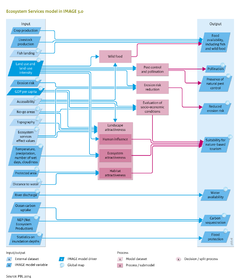Ecosystem services: Difference between revisions
Jump to navigation
Jump to search
m (RinekeOostenrijk moved page Ecosystem goods and services to Ecosystem services without leaving a redirect) |
No edit summary |
||
| Line 1: | Line 1: | ||
{{ComponentTemplate2 | {{ComponentTemplate2 | ||
|Application=Millennium Ecosystem Assessment - MA (2005) project | |||
|IMAGEComponent=Drivers; | |IMAGEComponent=Drivers; | ||
|InputVar=Temperature - grid; Precipitation - grid; Crop production; Livestock production; Erosion risk - grid; Protected area - grid; Ocean carbon uptake; NEP (net ecosystem production) - grid; Statistics on inundation depth - grid; River discharge - grid; Land use and land-use intensity - grid; GDP per capita - grid; Number of wet days - grid; Cloudiness - grid; | |KeyReference=Schulp et al., 2012; Van Kolck et al., in preparation; | ||
|Reference=Burkhard et al., 2012; MA, 2005; TEEB, 2010a; De Groot et al., 2012; Haines-Young and Potschin, 2013; TEEB, 2010b; Van Jaarsveld et al., 2005; Egoh et al., 2012; Bagstad et al., 2013; Garcia-Nieto et al., 2013; Foley et al., 2011; EC, 2012; | |||
|InputVar=Temperature - grid; Precipitation - grid; Crop production; Livestock production; Erosion risk - grid; Protected area - grid; Ocean carbon uptake; NEP (net ecosystem production) - grid; Statistics on inundation depth - grid; River discharge - grid; Land use and land-use intensity - grid; GDP per capita - grid; Number of wet days - grid; Cloudiness - grid; | |||
|Parameter=Topography - grid; Distance to water - grid; Fish landing - grid; Accessibility - grid; No-go areas - grid; Ecosystem services effect values - grid | |Parameter=Topography - grid; Distance to water - grid; Fish landing - grid; Accessibility - grid; No-go areas - grid; Ecosystem services effect values - grid | ||
|OutputVar=Suitability for nature-based tourism - grid; Presence of natural pest control - grid; Reduced erosion risk - grid; Food availability, including fish and wild food; Flood protection - grid; pollination - grid; Carbon sequestration - grid; Water availability - grid; | |OutputVar=Suitability for nature-based tourism - grid; Presence of natural pest control - grid; Reduced erosion risk - grid; Food availability, including fish and wild food; Flood protection - grid; pollination - grid; Carbon sequestration - grid; Water availability - grid; | ||
|Description= | |Description=Ecosystem services contribute to human well-being often in combination with other inputs ([[Burkhard et al., 2012]]). The identification and classification of the wide range of ecosystem services is still debated, but consensus is moving to the list of services published in the [[Millennium Ecosystem Assessment - MA (2005) project|Millennium Ecosystem Assessment]] (MA), and further elaborated in the TEEB study and the CICES project ([[MA, 2005]]; [[TEEB, 2010b]]; [[De Groot et al., 2012]]; [[Haines-Young and Potschin, 2013]]): | ||
* ''Provisioning services'': goods and products obtained directly from the ecosystem, such as food, water and wood; | |||
* ''Regulating services'': benefits associated with physical processes influenced by the ecosystem, such as climate regulation and erosion control; | |||
* ''Cultural services'': non-material benefits to humans such as recreation; | |||
* ''Supporting services'': Processes assisting the supply of other ecosystem services, such as soil nutrient cycling supporting the provisioning of agricultural production though often not identified as a separate category. | |||
Since the Millennium Ecosystem Assessment, the concept of ecosystems services has drawn increasing attention with many studies determining the influence on human well-being ([[Van Jaarsveld et al., 2005]]; [[TEEB, 2010b]]; [[TEEB, 2010a]]; [[Burkhard et al., 2012]]). For example, the TEEB study focused on the economic implications of the losses of a variety of ecosystem services , and other studies have tried to unravel the less tangible benefits of ecosystems to illustrate the importance of ecosystem conservation (Egoh et al., 2012]]; [[Bagstad et al., 2013]]; [[Garcia-Nieto et al., 2013]]). | |||
Understanding of ecosystem services is needed because pressures on ecosystems tend to increase as the world population grows and consumption patterns change. Unsustainable use and degradation of ecosystems may diminish delivery of services and may eventually impact on human well-being ([[MA, 2005]]; [[TEEB, 2010a]]; [[OECD, 2012]]). While food production, an ecosystem service itself, is increasing, it also puts pressure on other services, for instance by forest conversion to agricultural land may result in decreasing supply of clean water, ecotourism, and flood and drought control ([[MA, 2005]]; [[Foley et al., 2011]]). | |||
Growing concern about the unsustainable use has led to ecosystem services being incorporated in international and national policies. For example, the CBD Aichi targets endorsed by the EU biodiversity strategy address ecosystem services and the sustainable use of ecosystems ([[EC, 2012]]). | |||
Ecosystem services are closely linked to the core focus of the IMAGE 3.0 framework to analyse interactions between human and natural systems (see [[Framework introduction]]). The ecosystems services module quantifies the supply of services, defined as functioning of ecosystems to produce services in a given time period. To quantify ecosystem services, a range of indicators is used from other IMAGE components , together with additional relationships developed to establish supply of services ([[Schulp et al., 2012]]). To identify deficiencies and surpluses in ecosystem services, the calculated supply is compared with the potential requirement for these services at an appropriate spatial scale. | |||
|ComponentCode=EGS | |ComponentCode=EGS | ||
|AggregatedComponent=Impacts | |AggregatedComponent=Impacts | ||
|FrameworkElementType=impact component | |FrameworkElementType=impact component | ||
}} | }} | ||
Revision as of 06:46, 20 May 2014
Parts of Ecosystem services
| Component is implemented in: |
|
| Related IMAGE components |
| Projects/Applications |
| Key publications |
| References |
Key policy issues
- How would ecosystem services and the benefits from the natural environment develop in the absence of specific policies?
- How could policy interventions contribute to improving future ecosystem services?
- How could policy interventions influence the interaction between ecosystem services and other goals and ambitions, such as the millennium development goals?
